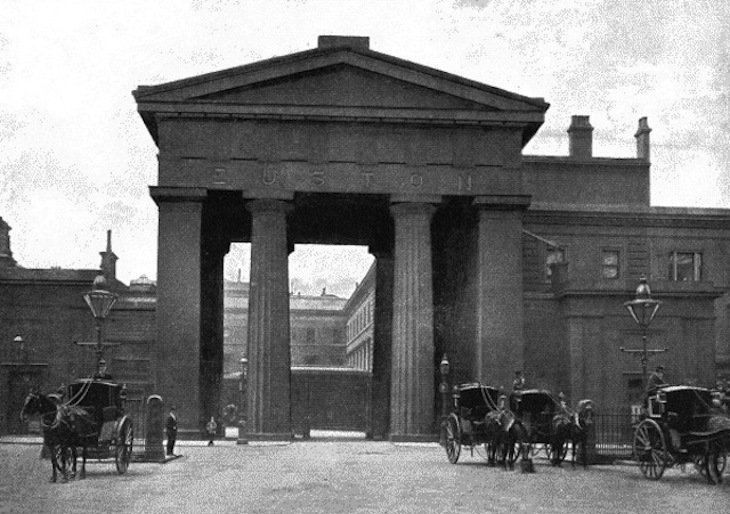London's a city in constant flux. Sometimes, you only have to turn your back for a little while and you'll find that bridge/museum/opera house isn't where you left it.
1) The Royal Opera House in Borough Market

Roast in Borough Market has a gorgeous façade — one that used to live in Covent Garden.
The portico used to be part of the Floral Hall at the Royal Opera House in Covent Garden, and was put into storage when that was redeveloped in the 1990s, before Borough Market bought it for £1. It's Grade II listed, and was designed by E M Barry.
2) The V&A Museum of Childhood in Bethnal Green

The V&A Museum hasn't always been in its lovely South Kensington home; it was previously located on the Mall and on Strand. But when it moved to South Kensington in 1857, the existing building on the site, Brompton Park House, was extended with galleries made from iron frameworks and clad with corrugated iron, which became known as 'Brompton Boilers'.
The 'Brompton Boilers' didn't last long. They were dismantled in 1867 and re-erected in Bethnal Green, where they were given new brick walls. They now form the V&A's eastern outpost, known until recently as the V&A Museum of Childhood and now reopened as the Young V&A.
3) London Bridge in Victoria Park and Guy's Hospital

It's no secret that parts of the medieval London Bridge — which spanned the Thames between the 13th and 19th centuries — can be seen all over the place. In 2016, we tracked down as many of them as we could as far afield as Kent, and possibly Derbyshire.
But if you want to catch a glimpse of the former river crossing, you don't need to venture that far. Four of the 14 alcoves are still here in London. Two are in use as shelters in Victoria Park, and one can be seen in the grounds of Guy's Hospital, close to the current London Bridge, and a fourth is situated in East Sheen.
4) The old Euston Doric Arch in an East End canal

You probably know that there used to be a Doric arch outside Euston station, famously removed despite a campaign to save it in the 1960s. But did you know it ended up in the bottom of an east London canal? Geoff Marshall covered it in our Secrets of London's Canals series:
If you want a closer look, here's a fluted section of one of the columns being removed from the river bed for BBC show One Foot In The Past. 29 further stones were recovered in 2009 when the Olympic Park was being redeveloped.
5) Marble Arch

The Euston arch isn't the only one that's been on the move. Marble Arch now has a station, roundabout, and whole area named after it, where the western end of Oxford Street meets Hyde Park.
However, the arch was first erected further south in 1827, where Buckingham Palace is. In fact, it was the ceremonial entrance to the palace. Then, Queen Victoria became the first monarch to use the palace as her official residence and it was extended to make room for visiting officials, diplomats and the like. The extension was the famous façade — including that balcony — that can be seen from The Mall today. Previously, the arch had stood on this spot, and had to be re-sited.
All of which leaves us wondering... what would Marble Arch tube station have been called, if the Marble Arch hadn't been moved? Tyburn, perhaps?
6) Crystal Palace
There's no longer a palace in Crystal Palace, which no doubt confuses optimistic tourists from time to time. But there once was — the Crystal Palace, which was originally built in Hyde Park to house the Great Exhibition of 1851. After the exhibition was over, the glass structure was painstakingly moved to Sydenham Hill, where it stood until it burnt down in 1936.
7) Waterloo Bridge in Harmondsworth

Before our current Waterloo Bridge, one designed by John Rennie spanned the Thames from 1817 to the 1930s. When this bridge was demolished, the granite stones it consisted of were sent all over the world to places including Canberra, Wellington, and (what is now) Zimbabwe as gifts to other Commonwealth countries.
According to London Remembers though, one stone didn't get that far. It can be seen on Harmondsworth Moor near Heathrow, hosting a plaque dedicated to the victims of a second world war aircraft crash.
8) Temple Bar

Sir Christopher Wren's Temple Bar originally marked the boundary between the City of London and Westminster (or, the boundary between Fleet Street and Strand). By Victorian times, it was causing traffic to bottleneck, so was removed and banished to Theobald's Park in Hertfordshire in the 1880s. Here, it was allowed to get into quite a dilapidated state, until 90 years later, a campaign to return the structure to the City of London was instigated. It was finely returned in 2002, when it was unveiled in Paternoster Square, next to St Paul's Cathedral.
Today, there's a plaque in Theobald's Park, marking where Temple Bar stood for all those years.
9) Chi Chi and Guy

Two of London Zoo's best-known past residents, Chi Chi the panda and Guy the gorilla, have both ended up at the Natural History Museum. The preserved specimens are on display for the public to appreciate.




